Tomato Pollination
Graphics
Images copyright 2000-2009, David L. Green
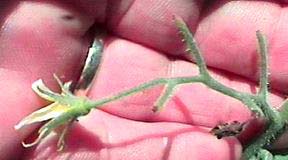 |
Blossom
Drop
Only one of these five blossoms still has a
chance to produce a fruit. Four have not been pollinated and are now useless. One on the
lower right is still clinging to its stem; three have already dropped. Why did so many not
pollinate? This problem causes a serious loss of yield. If the growing season is
short, one may not get tomatoes ripe in time before frost, as the early blossoms don't get
set. If one is growing for market, one usually wants to have them for the early market,
when prices are at their best. |
Structure
of the Tomato Blossom
(Shown upright for easier visualization; more often it extends out or down.)
Big Boy hybrid tomato, with front
parts removed to show the structure of the blossom. The ovary is at the base of the
flower, the pistil, made up of style and stigma is in the center. The style is the long
stalk reaching up to the bumpy and sticky stigma, which extends out well beyond the
surrounding stamens. |
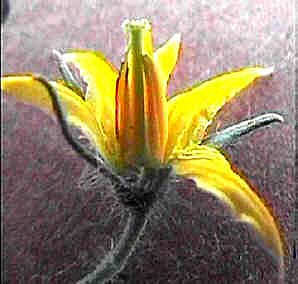 |
The wild progenitor
of our domestic tomato, in its native Peru, was pollinated by a solitary bee that was
specifically adapted to it. As tomatoes were carried to other areas, its pollinator did
not go with it, and pollination was often lacking. Humans, sometimes intentionally,
sometimes not, have been breeding tomatoes for the ability to self pollinate. That this
does not always happen, is shown in the frequent problem of blossom drop. Blossom
drop is almost always explained in terms of temperature or other growing conditions and
many tomato growers dismiss any possibility of bee involvement out of hand. This
prejudice may cost production, if even a small portion of the blossom drop is
actually preventable by bee activity.
The structure of the
blossom indicates a possibility, perhaps even a preference, for cross pollination, as the
stigma extends well beyond the anthers, and it grows into that position a couple days
before the anthers begin pollen shed. A fuzzy, electrostatically charged, and well-dusted
bee, that has just visited another flower (from another plant, called a pollenizer), can
brush against the stigma and coat it with pollen. Unfortunately, cross pollination does
not often occur. The native pollinator is absent, and other bees that might possibly
serve, are in short supply.
Tomatoes have another possible
route to go. The blossoms are self fertile, an attribute which is a defect in nature, but
which mankind has selectively bred for more pollination. A certain amount of self
pollination of tomato flowers does occur. But pollen does not move well by itself from
anther to stigma, as evidenced by the really poor pollination seen in greenhouses when no
pollination aid is given. But shaking by wind or mechanical means can cause the release of
the pollen, which drops down (the blossoms normally hanging downward) through the stamen
tube to the stigma. The best possible motion to release this pollen is from a bee
that "sonicates" Sonication is the vibration of the wing muscles without flight,
causing the whole flower to vibrate, and a cloud of pollen to be released onto the bee's
body and at the same time, onto the stigma. Not all bees sonicate. Today,
bumblebees, if they are around, will also sonicate and serve as a substitue for the native
pollinator bee.
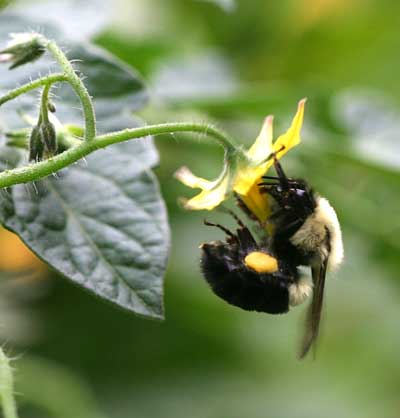
Bumblebee pollinating a tomato blossom, Image copyright 2009, David L. Green
Since tomatoes must have
help from bees, especially sonicating bees, or from wind, or other mechanical shaking to
reliably and consistantly produce a crop, they
cannot truly be said to be self pollinating. Greenhouse growers for many
years employed humans with electric vibrators (one brand name: Electric Bee!) to
accomplish pollination. Today these have been mostly replaced with cultured bumblebees who
do it more efficiently and cheaply.
Dr. Samuel McGregor, prior
to the development of bumblebees as greenhouse tomato pollinators, noted their value in
the field. McGregor, the author of the USDA's pollination "bible," also
suggested the possible importation of the native bee from Peru, as a way to improve
pollination. He commented...."the evidence indicates that if a heavy population of
insect visitors could be established, the effects would be beneficial.
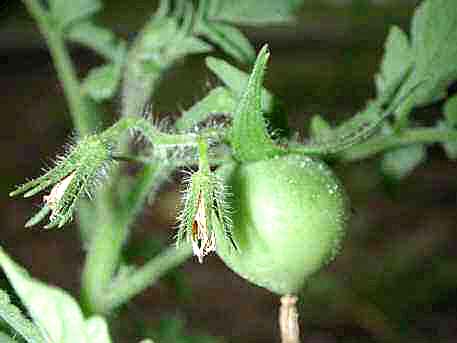
The culture of bumblebees
has grown almost explosively and now is a multimillion dollar enterprise, proving McGregor
a prophet. So far, the bees are almost exclusively used in greenhouses, but, as the price
comes down, they should also be available and useful in field situations.
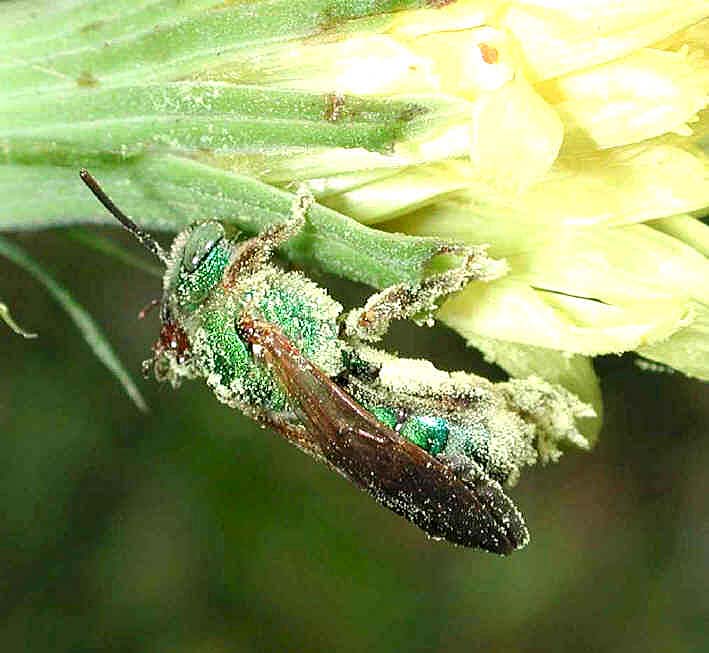
Image copyright 2001, David L. Green
Wild halictid bees, such as this (not sure
of the species). are thought to be the best wild pollinators in field
situations.
Unfortunately they are very sensitive to pesticides. Bumblebees
are the second best,
with honeybees a distant third, if they will work tomato blossoms.
Using a trimmer to mechanically pollinate tomatoes
I've got no
worms in my 'maters! Without poisons! In South Carolina!
More on Sonication (buzz pollination)
Home




